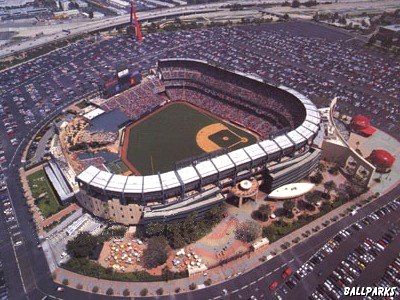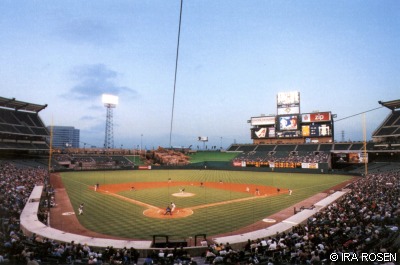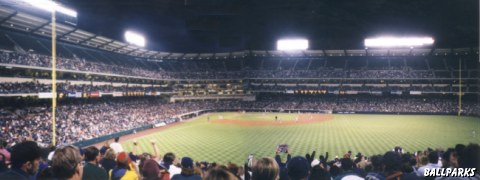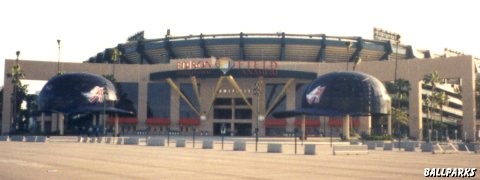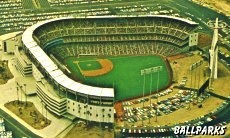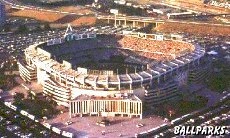Angel Stadium of Anaheim
formerly Anaheim Stadium and Edison International Field
Anaheim, California
Tenant: Los Angeles Angels (AL)
Opened: April 19, 1966
Construction began: August 31,1964
Surface: Bluegrass
Capacity: 43,000 (1966); 64,593 (1979); 33,851 (1997); 45,050 (1998)
Architect: HOK Sport (Kansas City, 1997-99 renovations)
Construction: Del E. Webb Company (1966); Turner Construction Company (1997-99 renovations)
Owner: City of Anaheim
Cost: $24 million (1966); $118 million (1997-99 renovations)
Lease: 33 year lease signed in 1996
Los Angeles Angels tickets:
Location: Left field (N), Katella Avenue; third base (W), 2000 State College Boulevard, then Interstate 5; first base (S), Orangewood Avenue; right field (E), Orange Freeway, then Santa Ana River; center field (NE), Amtrak Railroad Station.
Dimensions: Foul lines: 333 (1966), 330 (1997); bullpens: 362 (1966-1997); power alleys: 375 (1966), 369 (1973), 374 (1974), 370 (1989), 365 (1998); deep alleys: 386 (1966), 395 (1998); center field: 406 (1966), 402 (1973), 404 (1974), 406 (1998); backstop: 55 (1966), 60.5 (1973).
Fences: Majority of the fence: 10 (wire, 1966); 7.86 (wire, 1973); 7.86 (padded, 1981); corners between foul poles and bullpens: 4.75 (steel, 1966); left-center between 386 and 404 markers: 7.5 (padded, 1981); padded posts at the left sides of both left and right field; bullpen gates: 9.95 (wire, 1966), 9 (padded, 1981); left field to right center: 8 feet, right center to right field: 18 feet (1998).
In 1964 the Los Angeles Angels broke ground for Angel Stadium (then called Anaheim Stadium), a $24-million ballpark built on 140 acres. The team changed its name to the California Angels in 1965, and the stadium opened its gates for the 1966 season, drawing a first-game crowd of 31,660. A 1979 renovation changed the stadium into a completely enclosed, multipurpose facility, suitable for both professional football and baseball. Angel Stadium has twice hosted the All-Star Game (1967, 1989), and finally hosted a World Series in 2002. The largest crowd in franchise history: 64,406, saw the Angels beat Milwaukee, 8-3, in Game 1 of the 1982 ALCS.
On April 3, 1996, the city of Anaheim and the Angels (then owned by the Walt Disney Corporation) agreed on a deal that will keep the Angels in Anaheim until at least the year 2018. The Angels committed $88 million and the city $30 million to a three-year renovation of Angel Stadium to a more compact, baseball-only facility. The team changed its name to the Anaheim Angels for the 1997 season, but changed it back to the Los Angeles Angels for the 2005 season. The city provides 12,500 parking spaces on site for baseball and the Angels operate the stadium and retain all monies until agreed income thresholds are met. The agreement calls for the Angels to lease Angel Stadium for 33 years (3 for renovation and 30 for operation), but the team has the option to leave after 20 years of operation. Anaheim's plans for a sports and entertainment complex will be scaled back to 40 acres but the Angels agreed to allow the city to build a football stadium next to the ballpark.
Angel Stadium Trivia:
- Name changed to Edison International Field in 1997 under a $50 million, 20-year sponsorship deal.
- A.K.A. Big A (1966), Bigger A (1980), Big Ed (1998).
- Power hitter’s park, the ball carries well.
- Huge, 230-foot-high letter "A" stood behind the fence in left field as a scoreboard support until 1980, then was moved to the parking lot. The letter had a gold halo at its top.
- Four farms - Camille Allec’s 39 acres of orange and eucalyptus trees; Roland Reynolds’ 70 acres of alfalfa; John Knutgen’s 20 acres of corn; Bill Ross and George Lenney’s 19 acres of corn - previously were on the site of the current stadium.
- Sections 69 and 70 in center field were covered by green canvas batters’ background.
- Two thin black TV cables ran in fair territory on the warning track from the left field corner bullpen gate to the foul pole, then along the wall in foul territory about 50 feet toward third base, and then into the stands.
- There were six doors located on an ivy-covered wall in deep left-center behind outfield fence labeled "warning track," "skin material," "screen clay mounds," "raw clay," "sand," and "equipment."
- Bullpens moved in 1998 from behind the wall 10 yards inside each foul pole to behind the left field wall.
- Outfield Extravaganza area, the signature piece of the ballpark, is located behind the outfield wall in left center-field. It was designed to model the rocky California coastline and comes to life with a 90-foot-high geyser, fireworks and pyrotechnics to celebrate great plays on the field.
- The Pepsi Perfect Game Pavilion is an interactive area for both kids and adults.
More on Angel Stadium:
Recommended Reading (bibliography):
- Fodor's Baseball Vacations, 3rd Edition: Great Family Trips to Minor League and Classic Major League Ballparks Across America by Bruce Adams and Margaret Engel.
- The Ultimate Baseball Road-Trip: A Fan's Guide to Major League Stadiums by Joshua Pahigian and Kevin O'Connell.
- Joe Mock's Ballpark Guide by Joe Mock.
- Take Me Out to the Ballpark: An Illustrated Tour of Baseball Parks Past and Present by Josh Leventhal and Jessica Macmurray.
- The Ballpark Book: A Journey Through the Fields of Baseball Magic (Revised Edition) by Ron Smith and Kevin Belford.
- Ballparks: A Panoramic History by Marc Sandalow and Jim Sutton.
- Field of Schemes: How the Great Stadium Swindle Turns Public Money into Private Profit (2nd Edition) by Joanna Cagan and Neil deMause.
- Public Dollars, Private Stadiums: The Battle over Building Sports Stadiums by Kevin J. Delaney and Rick Eckstein.
- Sports, Jobs, and Taxes: The Economic Impact of Sports Teams and Stadiums by Roger G. Noll and Andrew Zimbalist.
Los Angeles Angels
Angel Stadium of Anaheim
2000 Gene Autry Way
Anaheim, California 92806
Help us provide a better web site by completing our feedback form
PHOTOGRAPHS:
Aerial view of Angel Stadium © 2003 by Mike Smith.
View inside Angel Stadium © 1999 by Ira Rosen.
Panoramic view inside Angel Stadium © 1998 by Chris Lamberth.
Panoramic view of the main entrance © 1998 by Chris Lamberth.
Aerial view of original stadium by Munsey & Suppes.
Aerial view of expanded stadium courtesy of Jeff Wright.
Updated April 2005
Tickets to Los Angeles Angels, Angels Dodgers, Angels Red Sox, NCAA Basketball Tournament, College Football Bowl, NCAA Football and Paul McCartney provided by Ticket Triangle.
BALLPARKS © 1996-2014 by Munsey & Suppes.
|

